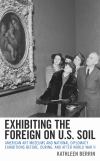Exhibiting the Foreign on U.S. Soil
American Art Museums and National Diplomacy Exhibitions before, during, and after World War II
Zusammenfassung
The uneasy relationship between the arts, US art museums, and the federal government has not been thoroughly explored by scholars. This book focuses on the development of “national diplomacy exhibitions” during World War II and the early Cold War and explains how the War provided the government with an impetus to create a national arts policy. It discusses how national diplomacy exhibitions on US soil were deployed as persuasive tools to influence public opinion, to reconcile discrepancies between high art and democracy, and to resolve America’s lagging art status and difficulties with “the foreign.” The type of soft diplomacy that art museums provide by initiating national diplomacy exhibitions has not received emphasis in the scholarly community and art museums have essentially been ignored in cultural studies of the early Cold War.
Scholarly analysis of museum exhibitions in the last quarter of the 20th century is now a popular topic, but investigations of exhibitions between 1939-1960 have been thin. By scrutinizing major exhibitions during those formative years this book takes a new perspective and examines the foundational development of the so-called “blockbuster” exhibition stimulated by World War II.
The book will interest readers in visual studies, history, museums, cultural affairs, government, and international diplomacy.
Schlagworte
World War II Museum Exhibits Museum of Modern Art History National Diplomacy Exhibits National Gallery of Art History OCIAA OCIAA Exhibits Office of the Coordinator of Inter-American Affairs Art and Politics Exhibiting Foreign Art- i–xx Preface i–xx
- 329–348 Bibliography 329–348
- 349–366 Index 349–366
- 367–368 About the Author 367–368

